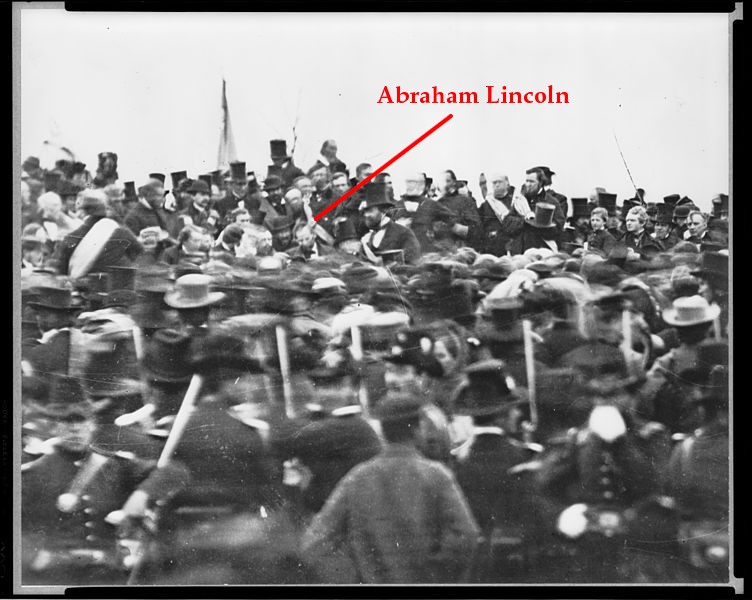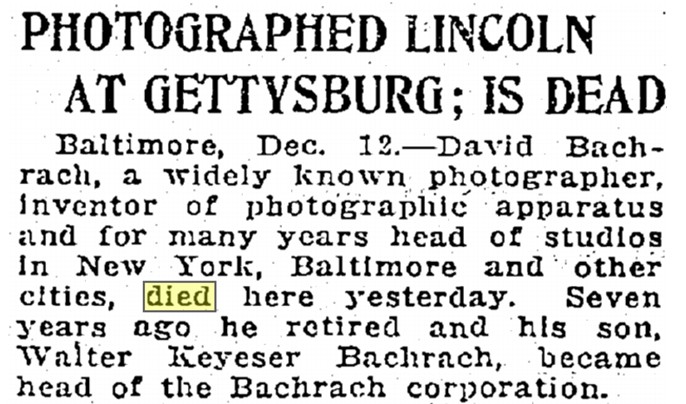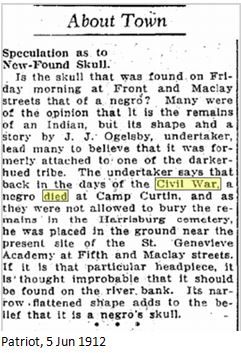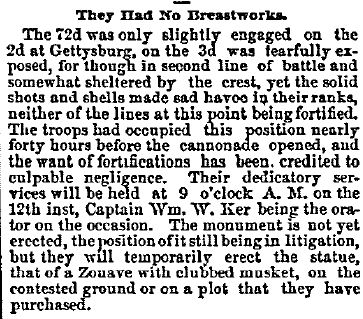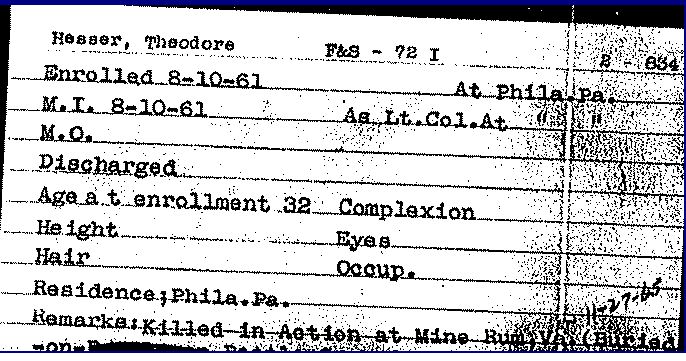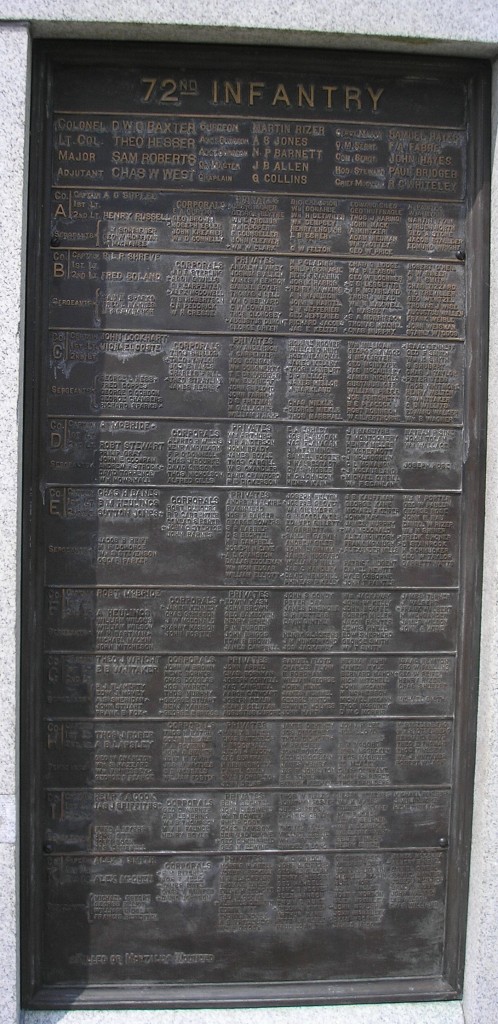Posted By Norman Gasbarro on December 7, 2014

The grave of Ambrose Baker of Company K of the 18th Pennsylvania Cavalry is located in Corinth Baptist Church Cemetery in Rugby, Grayson County, Virginia. According to a family tradition, Ambrose Baker began the Civil War fighting for the Confederacy, then “switched sides and fought for the Union.” The discovery of the grave site and marker was made by a descendant, who came to the conclusion that because the burial place was located in “deep, southwest Virginia,” that this led credence to the family tradition.
In an e-mail to the Civil War Research Project, dated 22 October 2013, the following information was provided about Ambrose Baker, along with a picture of the grave marker:
1. That he and his wife Charity Baker, married and raised four children in or around Rugby, Virginia, between the years 1885 and 1910; at least two of these children married, resided and raised 16 children in the same location between 1909 and 1930, or later.
2. According to census information, Ambrose Baker was born in May 1847. No census information was found for him for 1910. Charity Baker is named as a widow in the 1920 and 1930 censuses.
3. A death date for Ambrose Baker had not been found by family members. Note: there are no birth/death years on the grave marker.
The following information was located to substantiate that Ambrose Baker was in fact a Southerner, yet served in the 18th Pennsylvania Cavalry:
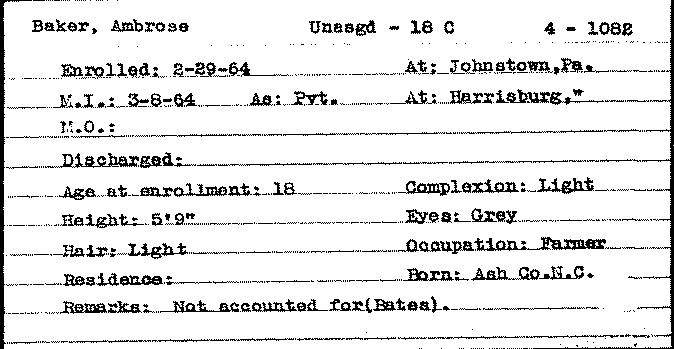
The Pennsylvania Veterans’ File Card (above) from the Pennsylvania Archives indicates that an Ambrose Baker enrolled in the 18th Pennsylvania Cavalry at Johnstown, Pennsylvania, on 29 February 1864, and was mustered into service in that regiment on 8 March 1864, but was not assigned to any particular company. At the time of his enrollment, he was 18 years old (born about 1846 or 1847), was 5 foot 9 inches in height, had light hair and complexion, and gray eyes. He gave his occupation as farmer and his birthplace as Ash County, North Carolina. The card also notes that he was “not accounted for” but does not give a date or reason. The Registers of Pennsylvania Volunteers (not shown), also from the Pennsylvania Archives, also give the “unassigned” status, but note that the enlistment was for a term of three years (or duration of the war).
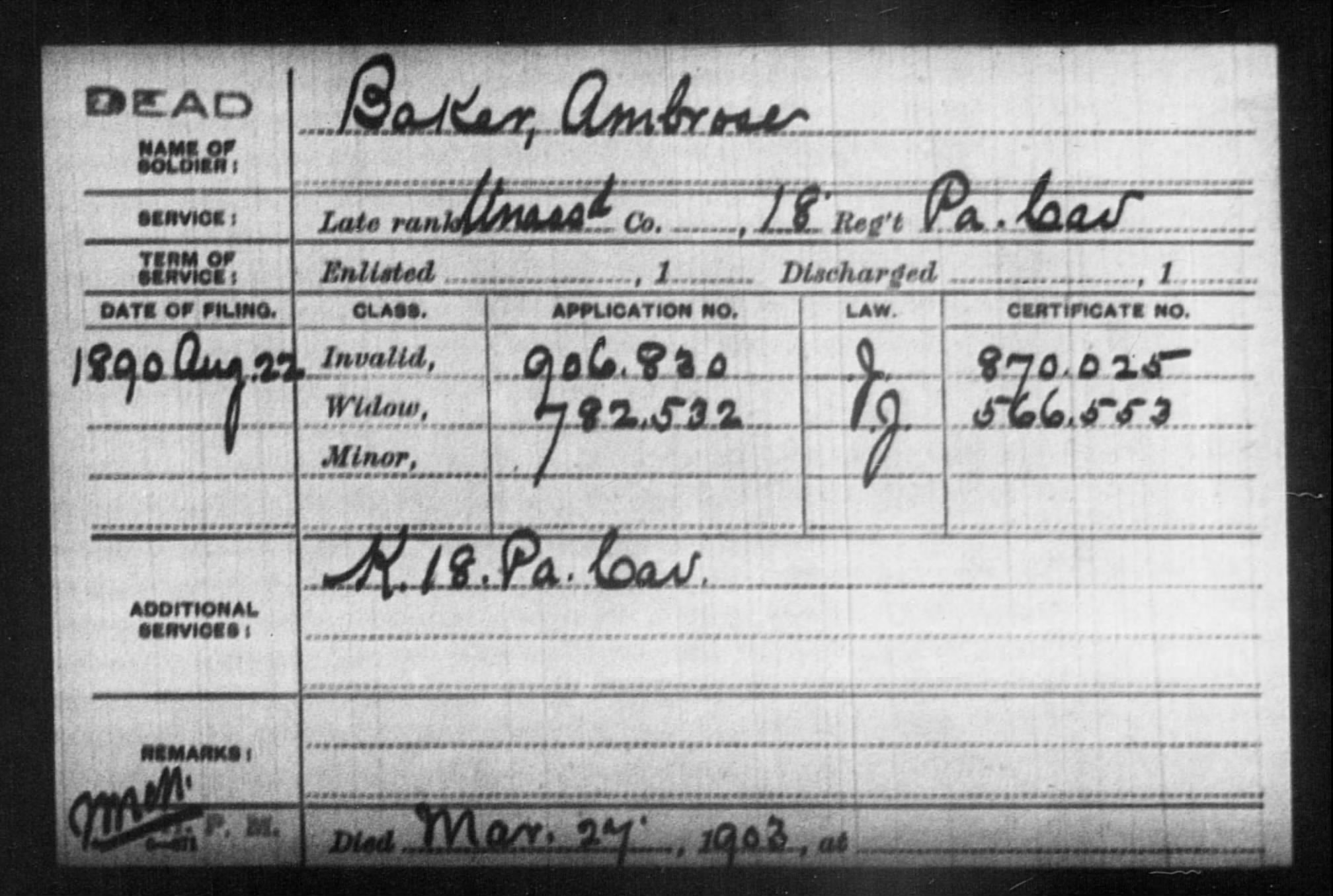
The Pension Index Card (above) from Fold3, for the Ambrose Baker who served in the 18th Pennsylvania Cavalry, Unassigned, also gives service in Company K of that regiment which is consistent with the information on the grave marker. Additional information from this card is that the initial pension application was made on 22 August 1890, that the pension was received, and that a widow applied after Ambrose’s death. The death date is given as 27 March 1903, but no place of death is noted. As previously noted here on this blog, these cards reference the actual pension application files available in the National Archives in Washington, D.C. Some information is not available on the Fold3 versions of the Pension Index Cards, so it is always wise to consult the Ancestry.com versions of the cards.
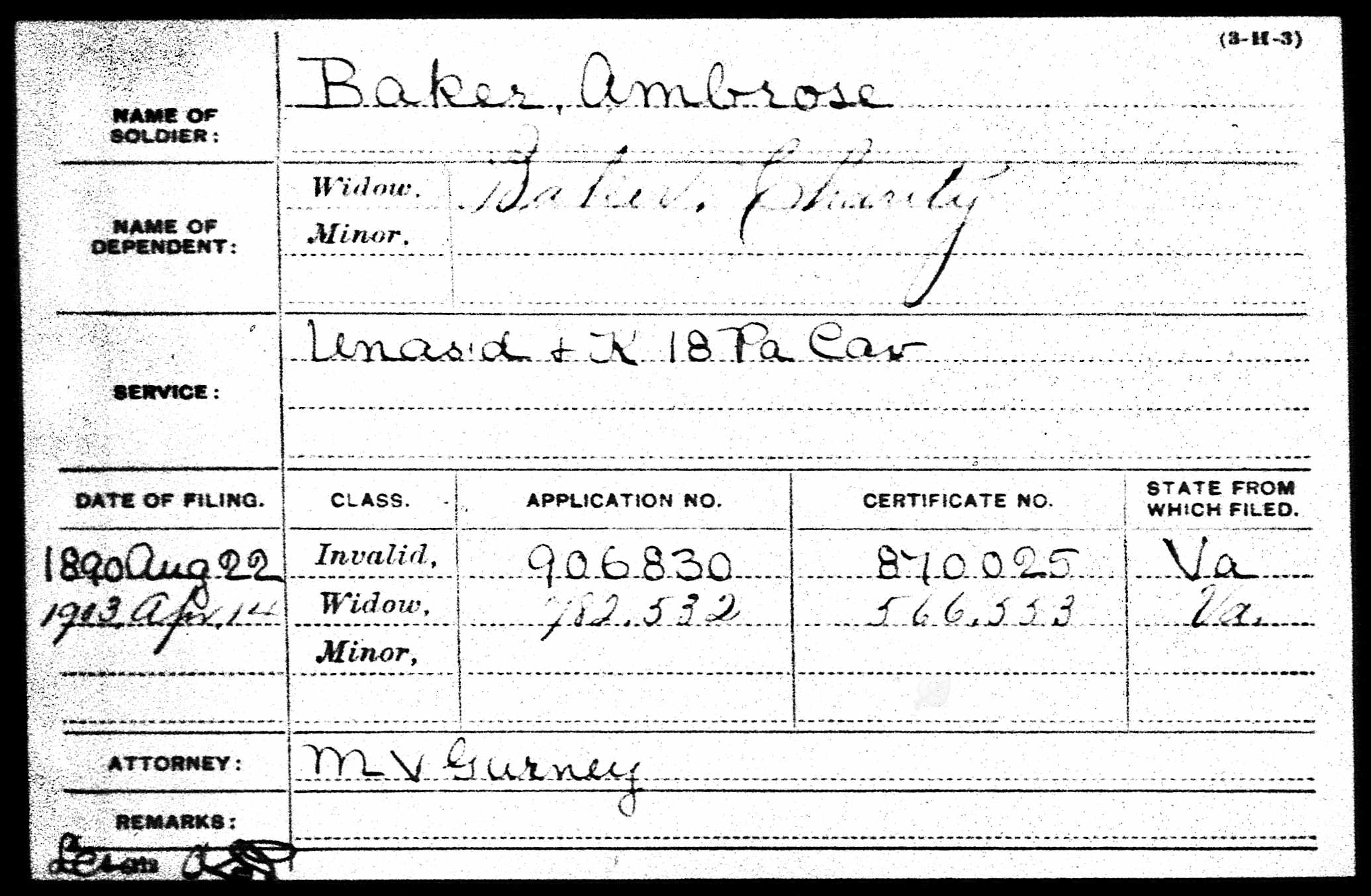
On the Ancestry.com version of the Pension Index Card (above), the widow’s name is given as Charity Baker (consistent with family and census information). The date of her application was 14 April 1903, which was less than a month after the death of Ambrose. New information on this card is the “State From Which Filed,” which confirms that both Ambrose (when he initially applied in 1890), and Charity (when she applied for the widow’s pension in 1903), were residents of Virginia (the state from which they applied for benefits).
It can be assumed from the two versions of the Pension Index Card, that Ambrose Baker completed his service in the 18th Pennsylvania Cavalry, and therefore was “accounted for” at muster out. A pension would not have been awarded for a deserter or someone missing in action. However, this does not rule out the possibility that he was either a prisoner of war or was in the hospital at the time of the muster out of the company and regiment. The information on his discharge would most likely be found in the full pension application files found in the National Archives in Washington, D. C.
Thus far, this does not answer the question of whether Ambrose Baker served in a Confederate military unit, however, his birthplace of Ash County, North Carolina, certainly places him in a state that seceded and was part of the Confederacy.

From the General Index Cards to military records (shown above) from Fold3, the “See Also” line indicates “Army of N. V.” perhaps meaning Army of Northern Virginia.
Speculation from this possibility would include a possible Confederate participation in the Battle of Gettysburg with capture, and then swearing allegiance to the Union followed by joining the 18th Pennsylvania Cavalry. A search of of Confederate regiments that participated in the Battle of Gettysburg, particularly those of North Carolina or Virginia origin, produced the following result in the Ancestry.com database, U. S. Civil War Soldiers and Profiles, 1861-1865:
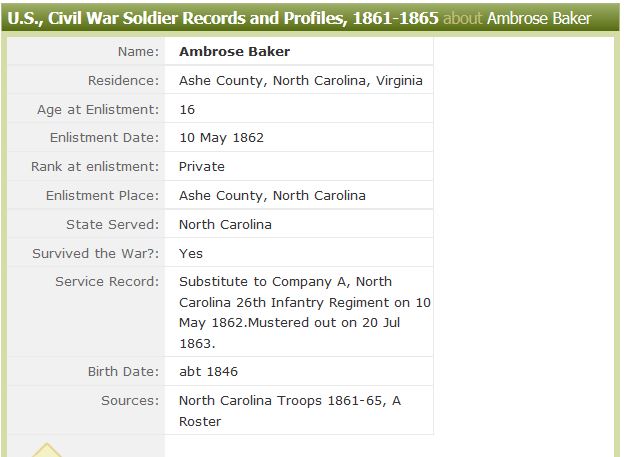
The above screen capture shows that an Ambrose Baker was mustered into service in the 26th North Carolina Infantry on 10 May 1862, that he was a resident of Ashe County, North Carolina, at the time (consistent with the birthplace information on the Pennsylvania Veterans’ File Card, above), and that he was mustered out of service on 20 July 1863. “Muster out” dates in this database do not necessarily mean that he was present at “muster out.” It could mean that he was unaccounted for as a result of being captured – at the Battle of Gettysburg – which occurred earlier in the month. And, he could have deserted his regiment and/or surrendered to Union forces.
At the Gettysburg Battlefield, there is a monument to the sacrifice of the 26th North Carolina Infantry. For a picture of that monument and a brief description of the action there, see the Stone Sentinel Web Site. Additional resources on the 26th North Carolina Infantry include the Wikipedia article and a history of the regiment (free download), 26th North Carolina Regimental History, by David H. McGee, which includes many pictures and maps.
While all of this analysis confirms that Ambrose Baker did indeed fight for the Confederacy and “later switched sides and fought for the Union,” it does not tell much about the man and the circumstances under which he “switched sides.” Further research into the pension and military records may give answers.
——————————
The following is a list of men who have some connection to the Lykens Valley area who served in the 18th Pennsylvania Cavalry:
Jacob Beller ——– B. Carman ——– Dalles David Ditty ——– Aaron C. Etzweiler ——– Jacob C. Fackler ——– George W. P. Freeland ——– Thaddeus S. Freeland ——– John D. Hoover ——– Joseph H. Kawel ——– John Kreiser ——– Josiah Lohr ——– William H. Poffenberger ——– William F. Polm ——– John B. Romberger ——– Edward Shade ——– Elias “Eli” Thomas ——– Solomon S. Updegrove ——– Isaac Newton Williamson ——– William Williard ——– George F. Wingard.
Category: Queries, Research, Stories |
1 Comment »
Tags:
 ;
;
